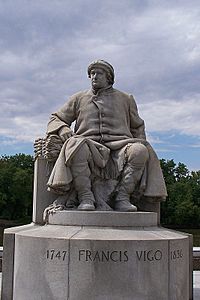Francis Vigo facts for kids
Quick facts for kids
Francis Vigo
|
|
|---|---|

Statue by John Angel dedicated to Francis Vigo on the waterfront of George Rogers Clark National Historical Park
|
|
| Birth name | Giuseppe Maria Francesco Vigo |
| Born | December 13, 1747 Mondovì, Piedmont, Kingdom of Sardinia, present-day Mondovì, Piedmont, Italy |
| Died | March 22, 1836 (aged 88–89) Vincennes, Knox County, Indiana |
| Buried |
Greenlawn Cemetery, Vincennes, Knox County, Indiana
|
| Allegiance | |
Francis Vigo (born Giuseppe Maria Francesco Vigo on December 13, 1747 – died March 22, 1836) was an Italian-American who helped the American forces during the Revolutionary War. He also played a part in starting a public university in Vincennes, Indiana.
Vigo was born in Mondovì, Italy. He served in the Spanish Army in New Orleans. In 1772, he started a business trading furs in St. Louis. Later, in 1783, Vigo moved his fur trading business to Vincennes.
Contents
Helping America in the Revolution
Francis Vigo often helped the American forces during the Revolutionary War. He was especially known for giving important information to George Rogers Clark.
A Spy for George Rogers Clark
Clark sent Vigo to Post Vincennes to check on the situation there. But Vigo was captured by Native Americans. They handed him over to Lt-Gov Henry Hamilton. Hamilton had taken Vincennes back for the British.
Vigo was a Spanish citizen. This meant he was not supposed to be involved in fighting in 1778. But Hamilton was suspicious of Vigo. He held Vigo on parole, which meant Vigo had limited freedom. The French citizens of Vincennes, led by Father Gibault, demanded Vigo's release. They threatened to stop supplying Fort Sackville if he wasn't freed.
Hamilton let Vigo go, but with a condition. Vigo had to promise not to harm British interests on his way to St. Louis. Vigo kept his promise. He traveled down the Wabash, Ohio, and Mississippi Rivers to St. Louis. Then, he returned to Kaskaskia. There, he told Colonel Clark about the British in Vincennes. This news led Clark to recapture the town in 1779.
Lending Money to the American Cause
Besides being a patriot and a spy, Vigo was a major supporter of the American Revolution. He helped pay for the war in the Northwest. When Clark arrived with paper money from the Continental Army, Vigo traded it for real coins. The American paper money was not worth much to the French citizens. Soon, it became completely worthless. Vigo was never paid back for his help during his lifetime. He used to say that the French word douleur meant grief or pain.
Life After the War
In the 1790s, Vigo continued his trading business. He traded with American merchants on the East Coast of the U.S.
Founding a University
In 1801, Vigo asked the U.S. Congress for land. He wanted to start the Jefferson Academy in Vincennes. In 1806, Vigo became one of the first trustees for the school. It was later renamed Vincennes University.
His Name Lives On
From 1790 to 1810, Vigo was a colonel in the Knox County Militia. He later resigned because of his age and health. In 1818, Vigo County, Indiana, was created and named after him.
On July 4, 1834, Vigo was honored in Terre Haute, Indiana. This city is the main town of Vigo County. After this visit, Vigo changed his will. He decided to leave money to buy a large bell for the Vigo County Courthouse. This would happen if the United States ever paid him back for his help during the Revolution.
Vigo's name is pronounced "VEE-goh" in Italian. However, many people in the U.S. say “VIH-go” when referring to places named after him.
His Final Years
Francis Vigo died on March 22, 1836. He was living in the home of Jean Baptiste and Elizabeth (Martin) LaPlante in Vincennes.
A Long-Awaited Payment
It took a long time, but in 1875, his estate was finally paid. The government paid $8,016.00 for the money he used to help Clark's plan to take Fort Detroit. This was the only cost the government officially recognized. But it also came with $41,282.60 in interest. Vigo did not have any direct family members. So, the government only had to pay for the things requested in Vigo's will. This included the bell for the courthouse in Vigo County.
Legacy
Vigo County, Indiana, located on the Wabash River north of Vincennes, is named for Francis Vigo. So is the town of Vigo, Indiana. The George Rogers Clark National Historical Park put up a statue of Vigo by John Angel in 1934. It stands on the waterfront of the Wabash River. Vigo was also featured on a special coin. This coin celebrated the 200th birthday of Indiana statehood.

